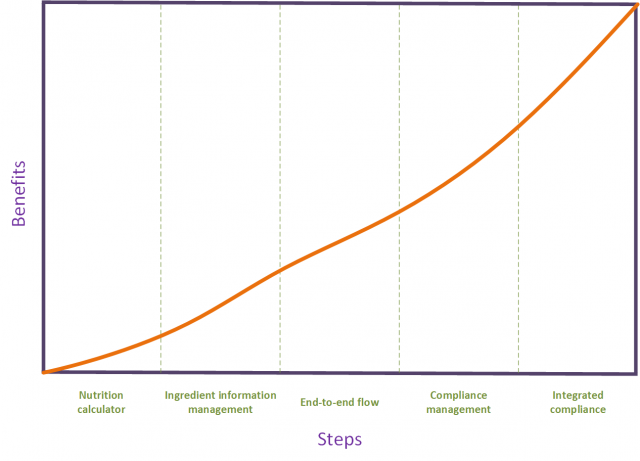Formulation management in 5 steps
In this post we look at the steps food & beverage companies take as they implement a formulation management system. I introduce the Hamilton Grant Formulation Management Maturity Model. This assesses an organisation’s formulation management maturity.
With so much focus on PLM, organisations often skip over how critical formulation management is to their success. Both to reduce risk and to develop better products faster. ERP systems and other elements of PLM control how products are made. But they do not control products’ compliance with customer requirements or regulations. Nor do they reduce the complexity product developers and quality managers face throughout the development process.
This is where a leading-edge formulation management system will transform your business. The chart below shows Hamilton Grant’s Formulation Management Maturity Model. It covers the five steps organisations take on the way to a leading-edge formulation management system.
Hamilton Grant’s Formulation Management Maturity Model

Step 1: Nutrition calculation
Product developers typically start looking for a nutritional calculator or similar product development tool. These tools save time and so deliver benefits to individuals in your organisation. But as they may or may not be adopted in the same way across your business, they don’t significantly reduce risk or improve customer responsiveness for your organisation. As they rely on nutritional databanks or information to hand, neither do they increase product information accuracy.
Step 2: Accurate and up-to-date ingredient information
You can’t publish accurate and timely product information without accurate and up-to-date ingredient information. You normally collect these from suppliers as raw material specifications or product information forms (PIFs). Organisations often feel this information is incomplete and out of date. Implementing a system to collect, approve and keep supplier information up-to-date is essential if you aim to provide accurate and timely product information to your customers.
Step 3: End-to-end product information flow
You aim to provide accurate and timely product information to customers. So ingredient information must flow through your organisation from your suppliers, through recipe development and quality, to your customers. You’ve integrated your formulation management system with ERP so up-to-date codes, descriptions and costs are available in real time. Information flows automatically between systems and you have a single source of truth for all product information.
Wider organisational benefits kick in at this point. You’re responding to customers faster, with less effort and you’re confident in your published information.
Step 4: Compliance management
You’re confident every formulation in production complies with regulations and customer requirements. Your approvals processes for new, updated, alternative and deactivated formulations – as well as tight control of BOM updates to ERP – are embedded across your organization.
Step 5: Integrated compliance
In its most advanced stage, formulation management improves the compliance process’s efficiency. Rather than coming at the end, formulation compliance is a continual, automated assessment throughout development. Your response to formulation changes is standardised across your organisation – such as under what circumstances you issue a product specification update to customers.
How can Hamilton Grant help?
Hamilton Grant’s Cloud applications provide off-the-shelf formulation management. There are several levels, depending on your ambitions and the complexity of your business.
For enterprise customers, Hamilton Grant offers benchmarking assessments based on the framework above and formulation management solutions, on premise or in the cloud, tailored to your specific needs.
